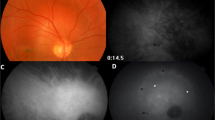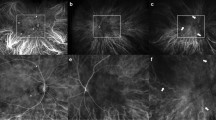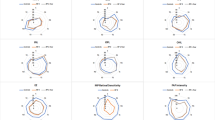Abstract
Aims
To correlate the hyperfluorescent lines in the peripheral fundus on late-phase indocyanine green angiography (ICGA) to infrared and optical coherence tomography (OCT) findings.
Methods
This is a retrospective, cross-sectional study. Multimodal imaging data, including ICGA, fluorescein angiography, infrared imaging, and OCT were analyzed. The hyperfluorescent lines were categorized into 2 grades according to their extents. In addition, serum levels of apolipoprotein (Apo) A and B were measured by enzyme linked immunosorbent assay.
Results
A total of 247 patients who underwent multimodal imaging were reviewed. The hyperfluorescent lines in the peripheral fundus on late-phase ICGA were detected in 96 patients, and were correlated to superficial choroidal arteries by infrared imaging and OCT. The incidence of hyperfluorescent choroidal arteries in the peripheral fundus (HCAP) on late-phase ICGA increased in groups of older ages (0–20 years, 4.3%; 20–40 years, 2.6%; 40–60 years, 48.9%; >60 years, 88.7%; p < 0.001). In addition, the mean age increased with the grades of HCAP (grade 1, 52.3 ± 10.8 years; grade 2, 63.3 ± 10.5 years; p < 0.001). The hyperfluorescence was also detected in posterior choroidal arteries in 11 eyes, all patients in grade 2. There was no significant correlation between grades of HCAP and gender, or serum level of ApoA and ApoB.
Conclusion
The occurrence and grades of HCAP increased with age. The superficial location of choroidal arteries in the peripheral fundus exposes their hyperfluorescence on late-phase ICGA. HCAP might reveal the local lipid degeneration of choroidal artery walls, according to ICG binding properties.
This is a preview of subscription content, access via your institution
Access options
Subscribe to this journal
Receive 18 print issues and online access
$259.00 per year
only $14.39 per issue
Buy this article
- Purchase on Springer Link
- Instant access to full article PDF
Prices may be subject to local taxes which are calculated during checkout



Similar content being viewed by others
Data availability
The data generated and analyzed during this study are available upon reasonable request from the corresponding author.
References
Herbort CP Jr, Tugal-Tutkun I, Mantovani A, Neri P, Khairallah M, Papasavvas I. Advances and potential new developments in imaging techniques for posterior uveitis Part 2: invasive imaging methods. Eye (Lond). 2021;35:52–73.
Gaudio PA, Kaye DB, Crawford JB. Histopathology of birdshot retinochoroidopathy. Br J Ophthalmol. 2002;86:1439–41.
Inomata H, Sakamoto T. Immunohistochemical studies of Vogt-Koyanagi-Harada disease with sunset sky fundus. Curr Eye Res. 1990;9:35–40.
Chen L, Yang P, Curcio CA. Visualizing lipid behind the retina in aging and age-related macular degeneration, via indocyanine green angiography (ASHS-LIA). Eye (Lond). 2022;36:1735–46.
Chen L, Zhang X, Li M, Gan Y, Wen F. Drusen and age-related scattered hypofluorescent spots on late-phase indocyanine green angiography, a candidate correlate of lipid accumulation. Invest Ophthalmol Vis Sci. 2018;59:5237–45.
Sikorski BL, Wojtkowski M, Kaluzny JJ, Szkulmowski M, Kowalczyk A. Correlation of spectral optical coherence tomography with fluorescein and indocyanine green angiography in multiple evanescent white dot syndrome. Br J Ophthalmol. 2008;92:1552–7.
Chang AA, Zhu M, Billson F. The interaction of indocyanine green with human retinal pigment epithelium. Invest Ophthalmol Vis Sci. 2005;46:1463–7.
Marchese A, Carnevali A, Sacconi R, Centoducati T, Querques L, Bandello F, et al. Retinal pigment epithelium humps in high myopia. Am J Ophthalmol. 2017;182:56–61.
Hoseini-Yazdi H, Vincent SJ, Collins MJ, Read SA, Alonso-Caneiro D. Wide-field choroidal thickness in myopes and emmetropes. Sci Rep. 2019;9:3474.
Chen L, Zhang X, Li M, Liao N, Wen F. Age-related scattered hypofluorescent spots on late-phase indocyanine green angiography as precursor lesions of polypoidal choroidal vasculopathy. Invest Ophthalmol Vis Sci. 2019;60:2102–9.
Chen L, Zhang X, Liu B, Mi L, Wen F. Age-related scattered hypofluorescent spots on late-phase indocyanine green angiography: the multimodal imaging and relevant factors. Clin Exp Ophthalmol. 2018;46:908–15.
Su Y, Zhang X, Chen L, Li M, Gan Y, Wen F. Age-related retentional avascular pigment epithelial detachment viewed with indocyanine green angiography. Retina. 2022;42:1520–8.
Desmettre T, Devoisselle JM, Mordon S. Fluorescence properties and metabolic features of indocyanine green (ICG) as related to angiography. Surv Ophthalmol. 2000;45:15–27.
Yoneya S, Saito T, Komatsu Y, Koyama I, Takahashi K, Duvoll-Young J. Binding properties of indocyanine green in human blood. Invest Ophthalmol Vis Sci. 1998;39:1286–90.
Rousseau A, Terrada C, Touhami S, Barreau E, Rothschild PR, Valleix S, et al. Angiographic signatures of the predominant form of familial transthyretin amyloidosis (Val30Met mutation). Am J Ophthalmol. 2018;192:169–77.
Mano F, Yonekawa Y, Kakihara S, Fortun J, Borrelli E, Bandello F, et al. Choroidal amyloid deposition: a multicenter study of amyloid lesions identified in late indocyanine green angiography. Retina. 2022;42:1989–94.
Tsai S, Vega GL. Coronary and peripheral artery plaques: do differences in plaque characteristics translate to differences in lipid management? J Investig Med. 2020;68:1141–51.
Funding
This work was supported by the National Natural Science Foundation of China (81870674, 82070970).
Author information
Authors and Affiliations
Contributions
MLL and XZZ contributed to study design. MLL was responsible for collecting data, interpreting data, and writing the report. YYJ and LM contributed to data collection and reviewing the report. FW supervised the study, analyzed data and reviewed the report.
Corresponding author
Ethics declarations
Competing interests
The authors declare no competing interests.
Additional information
Publisher’s note Springer Nature remains neutral with regard to jurisdictional claims in published maps and institutional affiliations.
Rights and permissions
Springer Nature or its licensor (e.g. a society or other partner) holds exclusive rights to this article under a publishing agreement with the author(s) or other rightsholder(s); author self-archiving of the accepted manuscript version of this article is solely governed by the terms of such publishing agreement and applicable law.
About this article
Cite this article
Li, M., Zhang, X., Ji, Y. et al. Hyperfluorescence of choroidal arteries in the peripheral fundus on late-phase ICGA. Eye 37, 3502–3505 (2023). https://doi.org/10.1038/s41433-023-02545-5
Received:
Revised:
Accepted:
Published:
Issue Date:
DOI: https://doi.org/10.1038/s41433-023-02545-5



